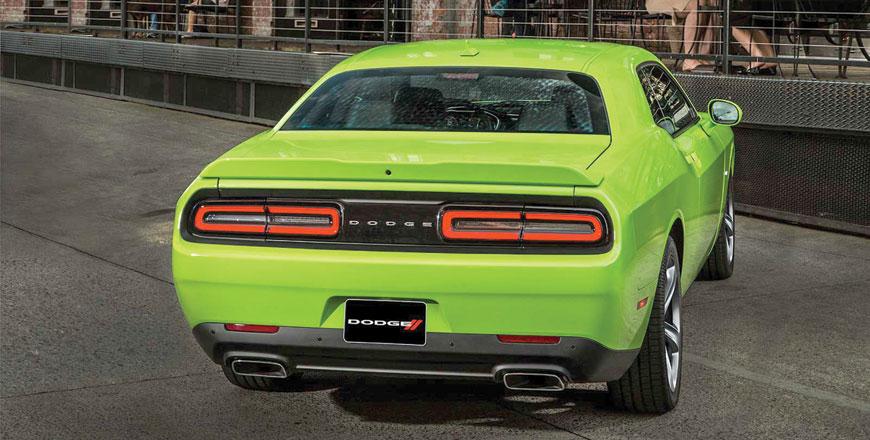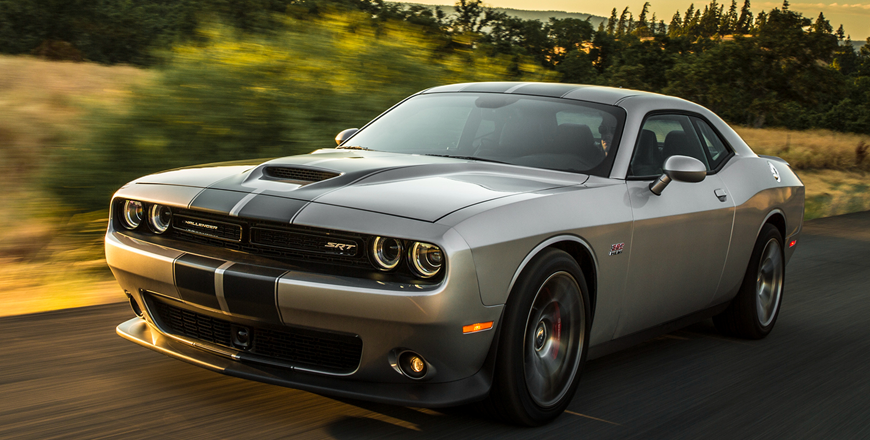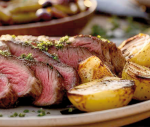You are here
Moody muscle car makeover
By Ghaith Madadha - Jul 20,2015 - Last updated at Jul 20,2015

Photo courtesy of Dodge
Introduced as a 2008 model heavily influenced by the ionic original 1970-74, the revived third generation Challenger was Dodge’s gambit into retro-inspired and renewed muscle car showdown between America’s “big three”. Large, comfortable, brawny and stylised, the Challenger perhaps best captured the spirit and aesthetic of its muscle car roots.
Revised to compete with all-new recently launched Ford Mustang and imminent Chevrolet Camaro archrivals, the 2015 Challenger significantly features a new 8-speed automatic gearbox and subtly face-lifted styling. In addition to revised interior, it also receives improved driver assistance, safety and infotainment systems and new colours, models and customisation options.
Imposing proportions
Closely following the curvature, profile proportions and styling details of the original 1970s Challenger, its contemporary successor is a similarly and gloriously moody and brutally aggressive design. With similarly long bonnet, evocative Coke-bottle hips and menacing deep-set quad headlights and wide rear lights, the modern Challenger is, however, taller and longer.
At 5-metre long and 1.9-metre wide, the Challenger well disguises its size, but with luxury saloon proportions and basic underpinnings, is more a grand tourer coupe than lithe sports car. With modern integrated bumpers, higher waistline, narrower glasshouse and larger wheels, the contemporary Challenger seems even more imposing than the original.
Lightly face-lifted, the 2015 Challenger’s most notably features a new split grille design inspired by the 1971 model and matching split — rather than full-length — LED rear light re-design. Along with new bold retro-influenced colours and alloy wheels, it also features new fog lights and projector headlamps with LED halo surrounds.
Muscular mid-range
With an extended model range including a devastating powerful 6.2-litre supercharged 707BHP SRT Hellcat halo version, Challenger engine options are otherwise little altered, including the 5.7-litre HEMI V8 Challenger R/T version tested. A modern interpretation of a charismatically traditional American OHV V8, the R/T’s is a robust and muscularly low-revving engine.
Developing 372BHP at 5200rpm and 400lb/ft at 4400rpm in 8-speed automatic guise as tested and 3BHP and 10lb/ft more with 6-speed manual gearbox, the Challenger R/T completes the 0-100km/h dash in approximately five-and-a-half seconds. Muscular and abundant in low- and mid-range, the R/T’s generous torque provides effortless on-the-move acceleration and flexibility.
Refined and relaxed speed, the R/T’s new 8-speed gearbox better utilises its generous but low-revving engine for improved off-the-line responses, versatility and refinement. Smooth and succinct in auto mode, the R/T’s paddle-shift actuated manual gearbox mode provides more control, but a low 5800rpm rev limit requires quick up-shifts for best results.
Confidence and refinement
A more practical and efficient car than the one it replaces, the 2015 Challenger R/T’s eight-speed gearbox and automatic four-cylinder de-activation when cruising allows for improved 12.3l/100km/combined cycle fuel consumption. Efficient for an 1852kg brute, the R/T can also be driven on cheaper minimum 91RON fuel requirement, but 93RON is recommended.
With unequal double wishbone front and multi-link rear suspension, long wheelbase and well-balanced weight distribution, the Challenger drives with big car confidence and stability at speed. Driven back-to-back with its four-door saloon Charger sister at Abu Dhabi’s Yas Marina Formula One circuit, the Challenger was more agile and eager through corners.
Riding on sticky low profile 245/45R20 tyres the Challenger R/T was grippy through corners yet felt refined and comfortable on the smooth Yas Marina tarmac. More agile through tight corners than its vast size and hefty weight suggest, the Challenger’s quick electric-assisted steering turns in tidily, with little body lean through corners.
Cabin comfort
Stable, refined and comfortable at speed, the Challenger is well-insulated from noise vibrations and harshness. Visibility from its hunkered narrow glasshouse cab was good on track. But, with high bonnet, beltline and boot, and vast dimensions, its’ blind spot and rear cross-path alerts and reversing camera are useful for congested public roads.
Large and comfortable, the Challenger features good front headspace, huge cabin width, and well-cushioned and adjustable seats and steering and user-friendly layouts. Seating three passengers in the rear and 458-litre luggage volume, the Challenger is practical. It features a driver-tilted console and retro-style analogue dials flanking a customisable TFT instrument panel.
Finished with extensive soft textures and generously equipped, the 2015 Challenger features a large, intuitive 8.4-inch Uconnect touchscreen with voice command, from which to access infotainment and driving systems and modes, including additional performance instrumentation. Driver assist and safety systems available also include adaptive cruise control and forward collision warning.
TECHNICAL SPECIFICATIONS
Engine: 5.7-litre, cast-iron block/aluminium head, in-line V8-cylinders
Bore x Stroke: 99.5 x 90.9mm
Compression ratio: 10.5:1
Valve-train: 16-valve, OHV
Gearbox: 8-speed automatic, rear-wheel drive
Gear ratios: 1st 4.70 2nd 3.13 3rd 2.10 4th 1.67 5th 1.28 6th 1.0 7th 0.84 8th 0.67
Reverse/final drive ratios: 3.53/3.08
Power, BHP (PS) [kW]: 372 (377) [277] @5200rpm
Specific power: 68.8BHP/litre
Power-to-weight: 200.86BHP/tonne
Torque lb/ft (Nm): 400 (542) @4400rpm
Specific torque: 95.86Nm/litre
Torque-to-weight: 292.65Nm/tonne
Rev limit: 5800rpm
0-100km/h: 5.5 seconds (est.)
Fuel consumption, city/highway/combined: 14.7/9.4/12.34/100km* *US EPA
Fuel capacity: 70 litres
Fuel requirement, recommended (minimum): 93(91)RON
Length: 5027mm
Width: 1923mm
Height: 1461mm
Wheelbase: 2951mm
Track, F/R: 1610/1621mm
Ground clearance: 132mm
Kerb weight: 1852kg
Weight distribution, F/R: 54.3 per cent/45.7 per cent
Aerodynamic drag co-efficiency: 0.337
Seating capacity: 2-door/5-seat
Headroom, F/R: 999/942mm
Legroom, F/R: 1067/840mm
Shoulder room, F/R: 1485/1368mm
Hip room, F/R: 1404/1215mm
Cargo volume: 458 litre
Steering: electric-assisted rack & pinion
Turning circle: 11.4 metres
Lock-to-lock: 2.62-turns
Suspension F/R: Unequal double wishbones/multi-link
Brakes, F/R: Ventilated discs 345 x 28mm/320 x 22mm
Brake calipers, F/R: dual-/single-piston
Tyres: 245/45R20
Related Articles
First introduced in its modern iteration in 2006 as a more sophisticated interpretation of the American saloon, with its combination of aggr
As a more mainstream brand large comfortable, spacious and sporty large rear-drive saloon, the Dodge Charger is a rare but appreciated commo
Introduced in 2015 as part of a revised Dodge Challenger coupe line-up, the SRT 392 is an evolution of the model line’s previous high perfor


















